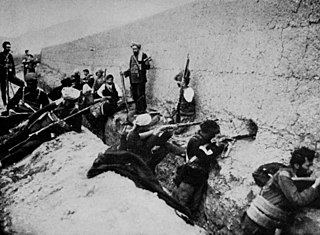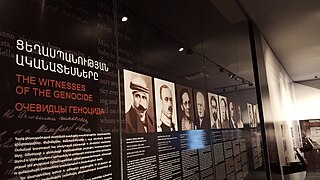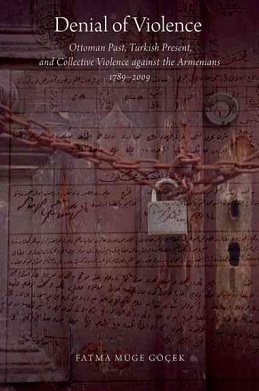
The Young Turk Revolution was a constitutionalist revolution in the Ottoman Empire. The Committee of Union and Progress (CUP), an organization of the Young Turks movement, forced Sultan Abdul Hamid II to restore the Ottoman Constitution and recall the parliament, which ushered in multi-party politics within the Empire. From the Young Turk Revolution to the Empire's end marks the Second Constitutional Era of the Ottoman Empire's history. More than three decades earlier, in 1876, constitutional monarchy had been established under Abdul Hamid during a period of time known as the First Constitutional Era, which lasted for only two years before Abdul Hamid suspended it and restored autocratic powers to himself.

Ahmet Rıza Bey was an Ottoman-born Turkish politician, educator, and a prominent member of the Young Turks, during the Second Constitutional Era of the Ottoman Empire. He was also a key early leader of the Committee of Union and Progress.

Armenian genocide denial is the claim that the Ottoman Empire and its ruling party, the Committee of Union and Progress (CUP), did not commit genocide against its Armenian citizens during World War I—a crime documented in a large body of evidence and affirmed by the vast majority of scholars. The perpetrators denied the genocide as they carried it out, claiming Armenians were resettled for military reasons, not exterminated. In the genocide's aftermath, incriminating documents were systematically destroyed, and denial has been the policy of every government of the Republic of Turkey, as of 2023.

The Urfa resistance was an effort by some Ottoman Armenians in Urfa to defend themselves against the Armenian genocide launched by the Ottoman Empire. The resistance was quelled following German intervention.

Armenian resistance included military, political, and humanitarian efforts to counter Ottoman forces and mitigate the Armenian genocide during the first World War. Early in World War I, the Ottoman Empire commenced efforts to eradicate Armenian culture and eliminate Armenian life, through acts of killing and death marches into uninhabitable deserts and mountain regions. The result was the homogenisation of the Ottoman Empire and elimination of 90% of the Armenian Ottoman population.
The University of Utah Press is the independent publishing branch of the University of Utah and is a division of the J. Willard Marriott Library. Founded in 1949 by A. Ray Olpin, it is also the oldest university press in Utah. The mission of the press is to "publish and disseminate scholarly books in selected fields, as well as other printed and recorded materials of significance to Utah, the region, the country, and the world."
Ronald Grigor Suny is an American historian and political scientist. Suny is the William H. Sewell Jr. Distinguished University Professor of History at the University of Michigan and served as director of the Eisenberg Institute for Historical Studies, 2009 to 2012 and was the Charles Tilly Collegiate Professor of Social and Political History at the University of Michigan from 2005 to 2015, and is Emeritus Professor of political science and history at the University of Chicago.
Ra's al-'Ayn camps were desert death camps near Ra's al-'Ayn city, where many Armenians were deported and slaughtered during the Armenian genocide. The site became "synonymous with Armenian suffering".

Witnesses and testimony provide an important and valuable insight into the events which occurred both during and after the Armenian genocide. The Armenian genocide was prepared and carried out by the Ottoman government in 1915 as well as in the following years. As a result of the genocide, as many as 1.5 million Armenians who were living in their ancestral homeland were deported and murdered.

Sürgün or verb form sürmek was a practice within the Ottoman Empire that entailed the movement of a large group of people from one region to another, often a form of forced migration imposed by state policy or international authority. The practice was also a form of banishment or exile often applied to the elites of Ottoman society, the Pashas. It was most famously used as a method to forcefully displace the native ethnic Armenians by the Young Turk government in 1915, in order to deal with a perceived threat from Armenian partisan groups receiving military support from the, Ottoman hostile, Russian Empire. These events are listed as one of the methods used to complete the Armenian Genocide.

The Fool is an 1880 Armenian language novel by the Armenian novelist Raffi, one of the best-known novels by one of Armenia's greatest novelists. The plot is based on the last Russo-Turkish War (1877–78), the plot tells a romance set against the background of the divided Armenian nation.
Bibliography of the Armenian genocide is a list of books about the Armenian genocide:
Fatma Müge Göçek is a Turkish sociologist and professor at the University of Michigan. She wrote the book Denial of Violence in 2015 concerning the prosectution of Armenians in the Ottoman Empire and Turkey, for which she received the Mary Douglas award for best book from the American Sociological Association. In 2017, she won a Distinguished Faculty Achievement Award from the university.

Denial of Violence: Ottoman Past, Turkish Present and Collective Violence Against the Armenians, 1789–2009 is a 2015 book by Turkish sociologist Fatma Müge Göçek which deals with the denial, justification, and rationalization of state-sponsored violence against Armenians in the Ottoman Empire and Turkey from the eighteenth to the twenty-first century, focusing especially on the Armenian genocide and its persistent denial in Turkey. Among the arguments made in the book is that the Armenian genocide was an act of foundational violence that enabled the creation of the Republic of Turkey and its continuing denial is an ideological foundation of the Turkish nation-state. The book was praised by reviewers for its extensive research and methodological innovation, although some noted that it was dense and not easy to read for those not familiar with the topic.
The Workshop for Armenian/Turkish Scholarship (WATS) is a group of scholars which is dedicated to transcending the nationalist historiography on the Armenian genocide and answering related questions. It first met in 2000. The workshop and the book it published were widely praised as first-class scholarship that significantly advanced the field. According to the workshop organizers, Turkish participants have faced state harassment for their participation.
The Armenian millet was the Ottoman millet of the Armenian Apostolic Church. It initially included not just Armenians in the Ottoman Empire but members of other Christian churches including the Coptic Church, Chaldean Catholic Church, Ethiopian Orthodox Tewahedo Church, and Syriac Orthodox Church, although most of these groups obtained their own millet in the nineteenth century. Mehmet II separated them from the Greek Orthodox because of the disagreements that they had over orthodoxy. The members of the millet were not only able to handle things autonomously, they had the legal status to bring a case to the Islamic courts. The Armenian millet did not have the ability to hold authority over the many people they were supposed to, and the Armenian patriarch's power had no real authority in Istanbul being so far from Anatolia.

Pro Armenia (1900–1914) was a French-language fortnightly that took pro-Armenian positions. The goal of the journal was to raise awareness in Europe about the plight of Armenians in the Ottoman Empire. It was founded at the initiative of Christapor Mikaelian, a co-founder of the Armenian Revolutionary Federation, enlisting the help of a number of prominent Dreyfusard and leftist intellectuals. Pierre Quillard was its editor-in-chief and Jean Longuet was its secretary. The members of its editorial committee were Georges Clemenceau, Anatole France, Jean Jaurès, Francis de Pressensé, and Edmond de Roberty. It temporarily ceased publication after the 1908 Ottoman constitutional revolution. It was published again in 1912 and 1913 under the title Pour les Peuples d’Orient. In 1914, the last year that the journal was published, it resumed its original name.
Bedross Der Matossian is an associate professor of Modern Middle East history and the Hymen Rosenberg Associate Professor in Judaic Studies at the University of Nebraska-Lincoln. He is also the vice chair of the Department of History. Der Matossian was born and raised in East Jerusalem. He is a graduate of the Hebrew University of Jerusalem, where he began his graduate studies in the Department of Islamic and Middle Eastern Studies. He completed his Ph.D. in Middle East History in the Department of Middle Eastern, South Asian, and African Studies at Columbia University in 2008. From 2008 to 2010, he was a lecturer of Middle East History in the Faculty of History at the Massachusetts Institute of Technology. For the Spring quarter 2014 he was appointed as the Dumanian Visiting professor in the University of Chicago. His areas of interest include ethnic politics in the Middle East, inter-ethnic violence in the Ottoman Empire, Palestinian history, and the history of Armenian Genocide. Der Matossian was the past president of the Society for Armenian Studies. He is also the series editor of "Armenians in the Modern and Early Modern World". published by I.B.Tauris and Bloomsbury Press. He serves on the Board of Directors of multiple international educational institutions and on the editorial board of multiple journals, the most prominent of which is the flagship journal of the field: International Journal of Middle East Studies (IJMES).

Differing views of what caused the Armenian genocide include explanations focusing on nationalism, religion, and wartime radicalization and continue to be debated among scholars. In the twenty-first century, focus has shifted to multicausal explanations. Most historians agree that the genocide was not premeditated before World War I, but the role of contingency, ideology, and long-term structural factors in causing the genocide continues to be discussed.











